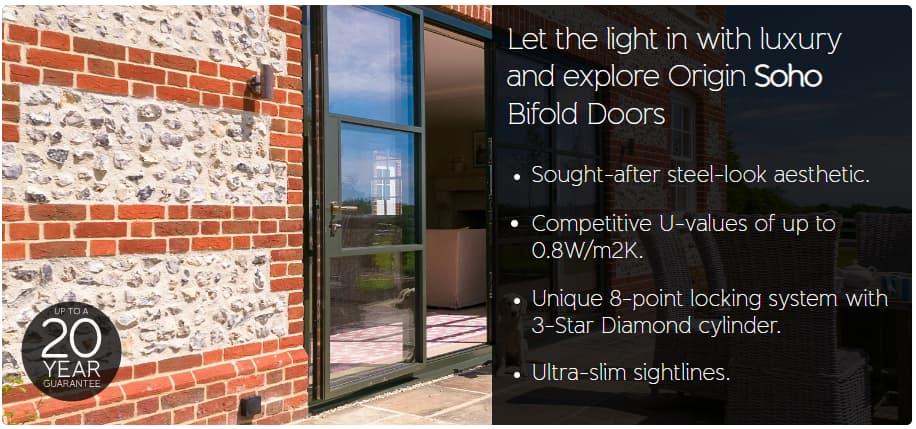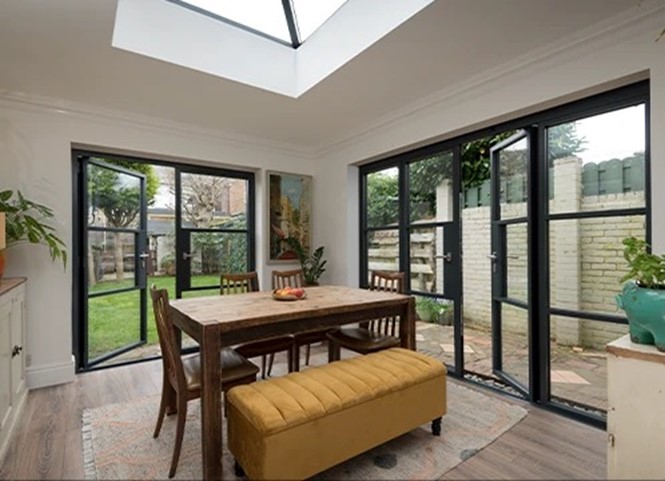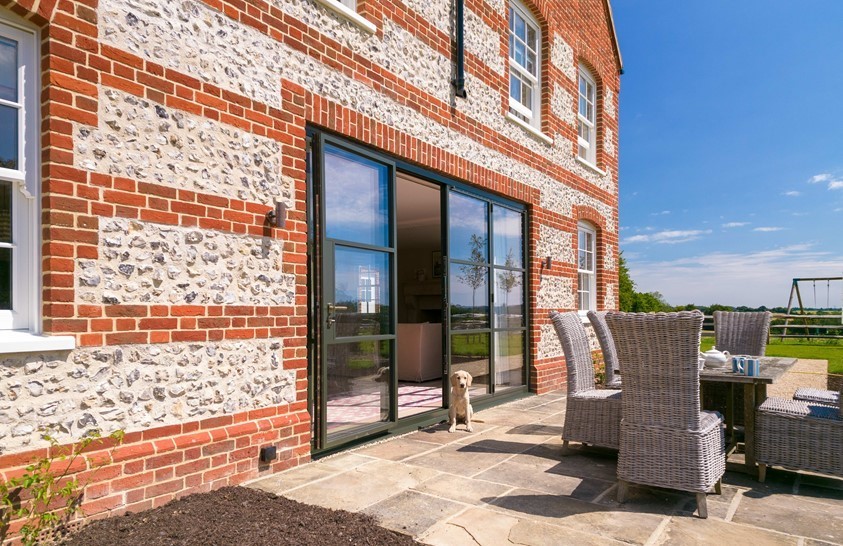Bifold doors, especially external bifold doors, have become a common feature in modern homes due to their ability to enhance both functionality and aesthetic appeal. When buying bifold doors, the material you choose is key to achieving the perfect solution for your home. Aluminium and uPVC are the two leading materials on the market for bifold doors, both offering distinct benefits and different features that can influence your decision.
In this expert guide, we’ll compare aluminium and uPVC in terms of durability, thermal efficiency, aesthetic appeal, and cost.
In this guide:
Read our quick overview of uPVC vs aluminium bifold doors.
Find out the differences between each material in terms of strength and durability.
Find out how each option differs in terms of aesthetics.
Read which option is more thermally efficient.
Find out more about the differences in cost between aluminium and uPVC.
Find out which option is more convenient in terms of maintenance.
We answer common queries on aluminium and uPVC bifold doors.
Comparing aluminium and uPVC bifold doors: An overview
Key characteristics of aluminium bifold doors
Aluminium bifold doors are known for their slim frames and sleek design, often providing a luxurious feel to any home. Aluminium bifold doors allow for slim sightlines, which results in excellent views and plenty of natural light entering your home. This characteristic alone makes them a top contender for those seeking a modern look. For example Origin Soho Bifold Doors have a sightline of just 36mm, allowing an abundance of natural light to flood into a home.
Aluminium is also incredibly durable, with a robust structure that can withstand extreme weather conditions. Thanks to powder coating and the option of a variety of RAL colours, aluminium bifold doors can be customised to match your home’s existing style while offering a durable finish that lasts for years. Additionally, modern aluminium doors feature advanced thermal break technology and offer excellent U-values, making them a great choice for energy-conscious homeowners. Find out more about the benefits of aluminium bifolds here.

What are the characteristics of uPVC bifold doors?
uPVC, short for unplasticised polyvinyl chloride, is another popular material choice for bifold doors. uPVC frames require little maintenance and are resistant to rot, rust, and corrosion, making them a perfect solution for homeowners seeking convenience and longevity at a lower additional cost compared to aluminium. uPVC bifold doors are also available in a range of styles and finishes, including wood-effect options for those who prefer a more traditional look.
Durability and longevity: Aluminium vs uPVC
How aluminium stands the test of time
Aluminium bifold doors are renowned for their strength and years of service. The material is naturally resistant to warping, cracking, and expanding under temperature fluctuations, which makes it ideal for areas prone to extreme weather. With a robust structure, aluminium bifold doors can easily handle heavy usage without losing their structural integrity. When treated with powder coating, aluminium doors have an incredibly durable finish.

Assessing uPVC's durability
uPVC bifold doors, while not as robust or strong as aluminium, still have some benefits when it comes to durability. uPVC is known for its ability to withstand UV rays and unlike wood, doesn’t rust or rot, even in coastal areas. However, uPVC doors can expand and contract with temperature changes, which may affect their performance over time. Though uPVC may not have the same years of service as aluminium, it remains a convenient and low-maintenance option.

Read how our Soho bifold doors completed this stylish home.
Aesthetic considerations when choosing your option
The sleek appeal of aluminium frames
When it comes to aesthetic preferences, aluminium bifold doors often stand out due to their modern, slimmer frames and minimalist appearance. Homeowners looking to create a sense of openness and maximise the view from their patio doors or bifold patio doors will appreciate aluminium's ability to incorporate larger panes of glass with slim sightlines. Aluminium profiles can be customised in a variety of RAL colours, allowing homeowners to add a splash of colour to their exterior doors or match the doors to existing home finishes. With a wide choice of colours available, you can find an option to suit any aesthetic. The material is very strong and flexible so complex layouts can be accommodated and the doors can be fully customised.
The design options of uPVC
uPVC bifold doors are often associated with a more traditional look, making them an excellent choice for homeowners who want a timeless appearance. uPVC frames can provide a classic aesthetic that pairs well with a variety of architectural styles. uPVC doors are also available in different colours, although they do not offer as many customisation options as aluminium in terms of RAL colours or texture. They also often appear bulkier than aluminium bifold doors, making aluminium bifold doors the winner in terms of flexibility and aesthetic.
Are you looking for a Soho-style bifold door? Explore our Origin Soho External Door

Our all-new Soho Collection epitomises the pinnacle of luxury and style. With sightlines of just 36mm, the Soho External Door provides extensive glass panels for maximum light and eye-catching aesthetics for any property development. The sought after steel-look seamlessly merges cutting-edge design and ultra-slim sightlines with unparalleled functionality.
Soho products have been engineered to outperform all building regulations and aid in minimising a home’s energy bills.
Contact your local installer today to bring your vison to life.
Energy efficiency and thermal performance
Aluminium doors and thermal break technology
Historically, aluminium was seen as a poor insulator. However, modern aluminium bifold doors are equipped with thermal break technology that significantly improves their thermal efficiency. This technology creates a barrier between the inside and outside of the door, reducing heat transfer and contributing to a more energy-efficient home. While aluminium doors may have a slightly higher initial investment, their excellent thermal efficiency and long-term energy savings make them a strong competitor to uPVC in this category. Modern aluminium bifold doors are often available with triple glazing options, and high-quality suppliers offer extremely low U-values. For example, Origin Soho Bifold Doors have been engineered to outperform all building regulations and aid in minimising a home’s energy bills. The polyamide thermal break is a less conductive material than aluminium, so it creates a barrier that separates the aluminium frame into two pieces. This reduces the flow of thermal energy through the aluminium, which means more heat is retained inside the home.
UPVC's insulation properties
uPVC bifold doors are naturally insulating, making them highly energy efficient. The material’s thermal properties help reduce heat loss, keeping your home warmer in the winter and cooler in the summer. uPVC’s insulation properties are one of its key selling points, offering excellent thermal efficiency without the need for additional technologies.
Read our full guide to aluminium bifold door thermal efficiency here.
Cost analysis: Initial investment vs long-term value
Upfront costs of aluminium and uPVC doors
In terms of upfront costs, aluminium bifold doors tend to be more expensive than uPVC. The higher cost of aluminium is due to its durability, slimmer frames, and modern aesthetic appeal. However, for many homeowners, the additional cost of aluminium is justified by its longevity, sleek appearance and they view aluminium bifold doors as a long-term investment.
uPVC bifold doors, on the other hand, are generally more affordable, making them a popular choice for budget-conscious homeowners. While they offer little maintenance and good thermal performance, they often don’t last as long as aluminium doors, which could lead to replacement costs in the future.
The initial cost of aluminium frames is more than uPVC frames. However, the strength and durability of aluminium means the frames last longer and often can potentially increase the value of your property. New uPVC doors will need replacing sooner because the frames are more susceptible to warping, expanding and contracting, and tend to look more worn over time.
Maintenance and replacement: Calculating the long-term savings
When evaluating long-term value, aluminium bifold doors often come out ahead due to their years of service and durable finish. They require minimal maintenance and can last for decades with proper care, offering significant savings in the long run.
uPVC doors, while low maintenance, may need to be replaced sooner than aluminium doors, especially in regions with extreme weather. While they offer a good return on investment initially, aluminium may prove more cost-effective over time. Read more about aluminium bifold door maintenance.

Frequently asked questions
Which material offers better security features?
Both aluminium and uPVC bifold doors offer robust security features. Aluminium doors, with their robust structure, tend to be stronger, making them harder to break into.
Which bifold door material lasts the longest?
Aluminium bifold doors typically last longer than uPVC due to their durability, strength, and resistance to warping or cracking.
Are uPVC bifold doors energy efficient?
Yes, uPVC bifold doors are highly energy efficient. Their natural insulation properties make them an excellent choice for homeowners looking to reduce heating and cooling costs.
Are uPVC bifold doors burglar proof?
While no door is entirely burglar-proof, uPVC bifold doors can be fitted with advanced locking systems to make them highly secure. However, aluminium doors generally offer a stronger frame, providing an additional layer of security.
How long do aluminium doors last?
With proper maintenance, aluminium doors can last for 30 years or more. Their durable finish and resistance to the elements contribute to their long lifespan.
Are solid wood doors energy efficient?
Solid wood doors can be energy efficient if properly insulated and sealed. However, they generally do not offer the same level of thermal efficiency as modern aluminium bifold doors such as Origin Bifold Doors.
Related Content
Frequently asked questions on thermal efficiency
How to choose a bifold patio door

